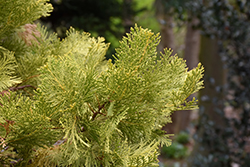It's all about ...
plants

Berrima Gold California Incense Cedar
Calocedrus decurrens 'Berrima Gold'
Height: 6 feet
Spread: 3 feet
Sunlight:
![]()
![]()
Hardiness Zone: 5a
Other Names: Incensecedar
Description:
A very slow growing, compact selection with a narrow, conical habit, featuring soft golden yellow foliage that is distinctive and beautiful, taking on coppery orange tones in winter; adaptable to many conditions but does best in areas of high humidity
Ornamental Features
Berrima Gold California Incense Cedar is a dwarf conifer which is primarily valued in the landscape or garden for its distinctively pyramidal habit of growth. It has attractive grayish green-variegated gold foliage with hints of chartreuse which emerges yellow in spring. The fragrant fan-shaped sprays of foliage are highly ornamental and turn outstanding shades of orange and coppery-bronze in the fall, which persists throughout the winter. The smooth bark and brick red branches are extremely showy and add significant winter interest.
Landscape Attributes
Berrima Gold California Incense Cedar is a multi-stemmed evergreen shrub with a distinctive and refined pyramidal form. Its relatively fine texture sets it apart from other landscape plants with less refined foliage.
This is a relatively low maintenance shrub, and is best pruned in late winter once the threat of extreme cold has passed. It has no significant negative characteristics.
Berrima Gold California Incense Cedar is recommended for the following landscape applications;
- Accent
- Hedges/Screening
- General Garden Use
Planting & Growing
Berrima Gold California Incense Cedar will grow to be about 6 feet tall at maturity, with a spread of 3 feet. It has a low canopy, and is suitable for planting under power lines. It grows at a slow rate, and under ideal conditions can be expected to live to a ripe old age of 100 years or more; think of this as a heritage shrub for future generations!
This shrub does best in full sun to partial shade. It is very adaptable to both dry and moist locations, and should do just fine under average home landscape conditions. It is not particular as to soil pH, but grows best in poor soils. It is quite intolerant of urban pollution, therefore inner city or urban streetside plantings are best avoided. This is a selection of a native North American species.
This plant is not reliably hardy in our region, and certain restrictions may apply; contact the store for more information.
